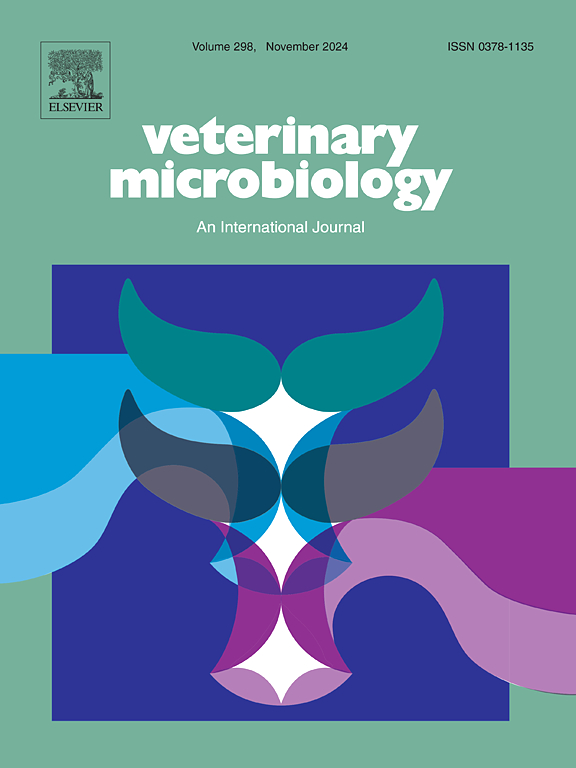阿隆山病毒在马体内的血清流行率
IF 2.7
2区 农林科学
Q3 MICROBIOLOGY
引用次数: 0
摘要
新病原体的出现对全球健康构成重大威胁,气候变化、生物多样性丧失和全球化加剧加剧了这一威胁。蜱作为各种病原体的载体,导致疾病发病率上升。监测项目对于识别和控制新出现的病原体至关重要。本次研究的重点是2017年在中国首次在人体中发现的一种分节状黄样病毒——阿隆山病毒(ALSV)。尽管它能够感染多种哺乳动物,但对ALSV的自然宿主和传播途径仍然知之甚少。因此,我们调查了来自不同地理区域的马群中ALSV的流行情况,以评估其传播和潜在风险。使用来自美洲、欧洲和大洋洲的商业血清库,我们在13个血清库中的12个检测到抗ALSV抗体,表明ALSV的地理分布比以前已知的更广泛。在一组来自德国的473匹纯种马中,87.1 %检测出ALSV抗体阳性,抗体阳性与年龄显著相关。对124匹马进行了5年的纵向追踪,发现抗体水平发生了动态变化,在研究期间的某一时刻,有71.77 %的测试呈阳性。我们的研究结果表明,在不同地区的马种群中,ALSV抗体的流行率很高,这表明经常接触该病毒。该研究强调了马作为监测蜱传病原体的哨兵模型的重要性,并强调需要进一步研究以了解接触ALSV对人类和动物健康的潜在风险。本文章由计算机程序翻译,如有差异,请以英文原文为准。
Seroprevalence of segmented flavi-like Alongshan virus in horses
The emergence of new pathogens poses a significant threat to global health, exacerbated by climate change, biodiversity loss, and increased globalization. Ticks, as vectors for various pathogens, contribute to the rising incidence of diseases. Surveillance programs are crucial for identifying and controlling emerging pathogens. This study focuses on the Alongshan virus (ALSV), a segmented flavi-like virus first identified in humans in China in 2017. Despite its ability to infect a wide range of mammals, the natural hosts and transmission pathways of ALSV remain poorly understood. Therefore, we investigated the prevalence of ALSV in equine cohorts from different geographical regions to assess its spread and potential risk.
Using commercial serum pools from the Americas, Europe, and Oceania, we detected anti-ALSV antibodies in 12 out of 13 pools, indicating a broader geographical distribution of ALSV than previously known. In a cohort of 473 Thoroughbred horses from Germany, 87.1 % tested positive for ALSV antibodies, with a significant correlation between antibody positivity and age. Longitudinal tracking of 124 horses over five years revealed dynamic changes in antibody levels, with 71.77 % testing positive at some point during the study.
Our findings demonstrate a high prevalence of ALSV antibodies in equine populations across diverse regions, suggesting frequent exposure to the virus. The study highlights the importance of horses as sentinel models for monitoring tick-borne pathogens and underscores the need for further research to understand the potential risk of ALSV exposure to human and animal health.
求助全文
通过发布文献求助,成功后即可免费获取论文全文。
去求助
来源期刊

Veterinary microbiology
农林科学-兽医学
CiteScore
5.90
自引率
6.10%
发文量
221
审稿时长
52 days
期刊介绍:
Veterinary Microbiology is concerned with microbial (bacterial, fungal, viral) diseases of domesticated vertebrate animals (livestock, companion animals, fur-bearing animals, game, poultry, fish) that supply food, other useful products or companionship. In addition, Microbial diseases of wild animals living in captivity, or as members of the feral fauna will also be considered if the infections are of interest because of their interrelation with humans (zoonoses) and/or domestic animals. Studies of antimicrobial resistance are also included, provided that the results represent a substantial advance in knowledge. Authors are strongly encouraged to read - prior to submission - the Editorials (''Scope or cope'' and ''Scope or cope II'') published previously in the journal. The Editors reserve the right to suggest submission to another journal for those papers which they feel would be more appropriate for consideration by that journal.
Original research papers of high quality and novelty on aspects of control, host response, molecular biology, pathogenesis, prevention, and treatment of microbial diseases of animals are published. Papers dealing primarily with immunology, epidemiology, molecular biology and antiviral or microbial agents will only be considered if they demonstrate a clear impact on a disease. Papers focusing solely on diagnostic techniques (such as another PCR protocol or ELISA) will not be published - focus should be on a microorganism and not on a particular technique. Papers only reporting microbial sequences, transcriptomics data, or proteomics data will not be considered unless the results represent a substantial advance in knowledge.
Drug trial papers will be considered if they have general application or significance. Papers on the identification of microorganisms will also be considered, but detailed taxonomic studies do not fall within the scope of the journal. Case reports will not be published, unless they have general application or contain novel aspects. Papers of geographically limited interest, which repeat what had been established elsewhere will not be considered. The readership of the journal is global.
 求助内容:
求助内容: 应助结果提醒方式:
应助结果提醒方式:


